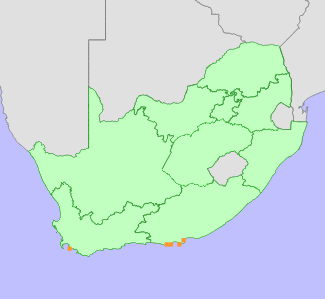|
Scientific Name | Satyrium hallackii Bolus subsp. hallackii |
Higher Classification | Monocotyledons |
Family | ORCHIDACEAE |
Synonyms | Satyrium foliosum Sw. var. helonioides Lindl. |
National Status |
Status and Criteria | Endangered A2c; B2ab(i,ii,iii,iv,v) |
Assessment Date | 2022/02/24 |
Assessor(s) | L. von Staden, W.R. Liltved & T.A. Oliver |
Justification | This Cape endemic has a restricted distribution with an extent of occurrence (EOO) of 14 637 km², and an area of occupancy (AOO) of 96 km². It is confined to coastal flats, with a disjunct distribution in the Western and Eastern Cape as far as Kei mouth/Kentani district. A 600 km distance separates the Western and Eastern Cape subpopulations. The subspecies is extinct or endangered throughout its range due to coastal and urban development. In the Western Cape, subpopulations at Hout Bay, Zeekoevlei, Muizenberg and the Cape Flats are now extinct. We suspect that there has be a 50% habitat loss over the past 15 years (three generations). Currently extant at only four sites, those surviving at Betty's Bay and southeast of Pearly Beach are severely threatened by urban expansion and encroachment from invasive alien vegetation. It is therefore assessed as Endangered under criteria A and B. |
Distribution |
Endemism | South African endemic |
Provincial distribution | Eastern Cape, Western Cape |
Range | This subspecies has a restricted distribution in the Western and Eastern Cape provinces, where it occurs from Betty's Bay, Pearly Beach, Cape St Francis, Komga and Kentani. |
Habitat and Ecology |
Major system | Terrestrial |
Major habitats | Overberg Dune Strandveld, Kogelberg Sandstone Fynbos, Hangklip Sand Fynbos, St Francis Dune Thicket |
Description | It is found in moist, sometimes brackish soils, in dune slacks immediately inland from the shoreline. |
Threats |
| It is threatened by urban development, agriculture and alien plants. Plants surviving at Betty's Bay, near Hermanus and southeast of Pearly Beach, are severely threatened by urbanization and alien vegetation infestation. (Ref: The Cape Orchids -- Wild orchids of the Cape Floral Kingdom. W.R. Liltved and S.D. Johnson). |
Population |
Population trend | Decreasing |
Conservation |
| It is not currently conserved in any formally protected area. |
Assessment History |
Taxon assessed |
Status and Criteria |
Citation/Red List version | | Satyrium hallackii Bolus subsp. hallackii | EN A2c; B2ab(i,ii,iii,iv,v) | Raimondo et al. (2009) | | Satyrium hallackii Bolus subsp. hallackii | EN B1B2bc | Victor (2002) | | Satyrium hallackii Bolus subsp. hallackii | Endangered | Hilton-Taylor (1996) | |
Bibliography |
Hall, A.V. 1982. A revision of the southern African species of Satyrium. Contributions from the Bolus Herbarium 10:1-142.
Hilton-Taylor, C. 1996. Red data list of southern African plants. Strelitzia 4. South African National Botanical Institute, Pretoria.
Johnson, S. and Bytebier, B. 2015. Orchids of South Africa: A field guide. Struik Nature, Cape Town.
Johnson, S.D. 1997. Pollination ecotypes of Satyrium hallackii (Orchidaceae) in South Africa. Botanical Journal of the Linnean Society 123:225-235.
Liltved, W.R. and Johnson, S.D. Unpublished. The Cape Orchids - Wild orchids of the Cape Floral Kingdom.
Linder, H.P. and Kurzweil, H. 1999. Orchids of southern Africa. A.A. Balkema, Rotterdam.
Raimondo, D., von Staden, L., Foden, W., Victor, J.E., Helme, N.A., Turner, R.C., Kamundi, D.A. and Manyama, P.A. 2009. Red List of South African Plants. Strelitzia 25. South African National Biodiversity Institute, Pretoria.
Victor, J.E. 2002. South Africa. In: J.S. Golding (ed), Southern African plant Red Data Lists. Southern African Botanical Diversity Network Report 14 (pp. 93-120), SABONET, Pretoria.
Victor, J.E. and Dold, A.P. 2003. Threatened plants of the Albany Centre of Floristic Endemism, South Africa. South African Journal of Science 99:437-446.
|
Citation |
| von Staden, L., Liltved, W.R. & Oliver, T.A. 2022. Satyrium hallackii Bolus subsp. hallackii. National Assessment: Red List of South African Plants version 2024.1. Accessed on 2025/12/08 |
 Comment on this assessment
Comment on this assessment


